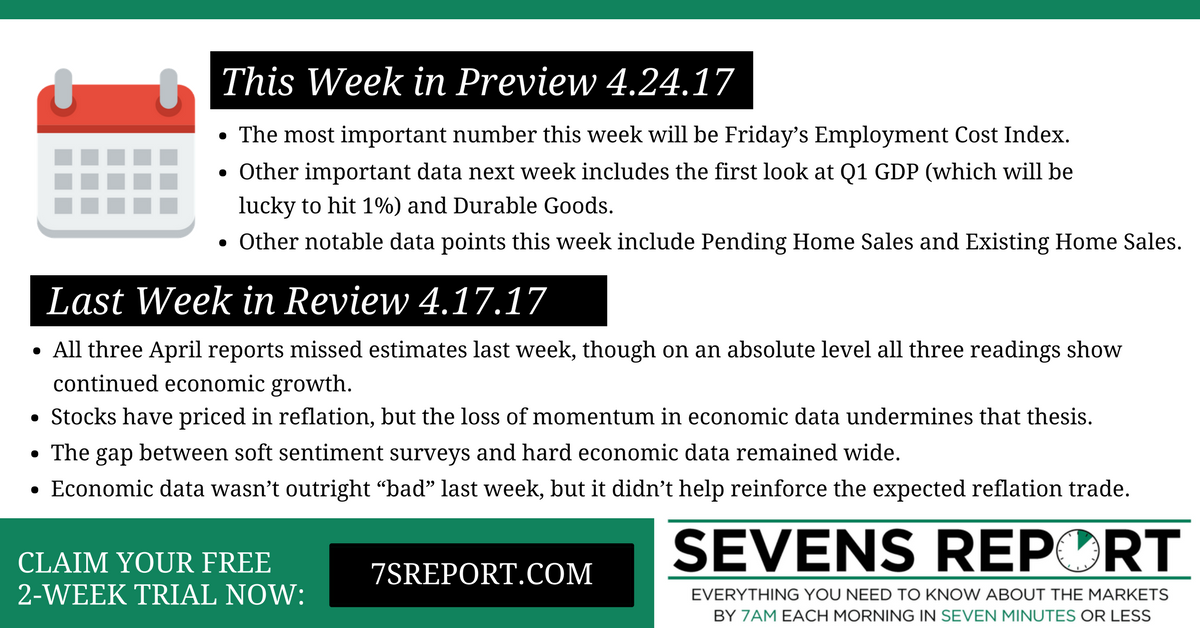Last Week and This Week in Economics, April 24, 2017
This Week/Last Week in Economics is a feature each Monday in the subscriber Sevens Report. Sign up for a totally free (no-credit-card required) two-week trial of the Sevens Report to get everything you need about the markets in your inbox by 7am each morning.

Last Week in Economics – 4.17.17
April economic data started with a bit of a thud as all three April reports missed estimates last week. And while on an absolute level the numbers imply economic activity remains “fine,” the lack of additional progress is contributing to growing doubts about the strength of expected economic reflation (and that’s why bond yields are lower than most expect).
Last week’s headline economic report, flash April Manufacturing PMI, missed expectations at 52.8 vs. (E) 53.9, and declined from the March reading. Likewise, April Empire Manufacturing and Philly Fed also missed expectations and declined from very high readings in March.
Now, to be clear, on an absolute level all three readings show continued economic growth, but again it’s the pace that matters. Stocks have priced in reflation, but the loss of momentum in economic data undermines that thesis, and that’s why stocks have grinded sideways now for six weeks.
Meanwhile, the gap between soft sentiment surveys and hard economic data remained wide. March Industrial Production beat estimates but that was only because of strong utility production given the March blizzard. The manufacturing sub-component declined and badly missed estimates, again providing non-confirmation for the still high (in absolutely terms) manufacturing PMIs.
Bottom line, economic data wasn’t outright “bad” last week, but it didn’t help reinforce the expected reflation trade, and that did at least partially stoke concerns about the pace of growth. Meanwhile, economic data didn’t help close the gap between hard and soft.
This Week in Economics – 4.24.17
The slow drip of economic data continues this week (next week is the big one), although given the precarious nature of the bond market (10-year yields signaling a potential slowdown) all economic data is at least partially important.
With that in mind, the most important number will be Friday’s Employment Cost Index. Inflation is a key component of the reflation trade, and any broader uptick in inflation has to come from increased wages. In Q1, wage data in the government jobs report wasn’t particularly strong. So, if the Employment Cost Index shows no real uptick in wage pressures, that will further undermine the reflation trade.
Other important data next week includes the first look at Q1 GDP (which will be lucky to hit 1%) and Durable Goods. Starting with GDP, it’s not going to be a strong report, but if consumer spending (PCE) is stronger than expected that will be a silver lining. Meanwhile, Durable Goods offers yet another opportunity for hard economic data to meet surging sentiment surveys, and in doing so close the gap between strong soft data and lackluster actual data. Other notable data points this week include Pending Home Sales and Existing Home Sales, both of which will be under more scrutiny following the disappointing Housing Market Index and Housing Starts numbers from last week.
Skip the jargon, arcane details and drab statistics from in-house research, and get the simple analysis that will improve your performance. Get your free trial of the Sevens Report today.